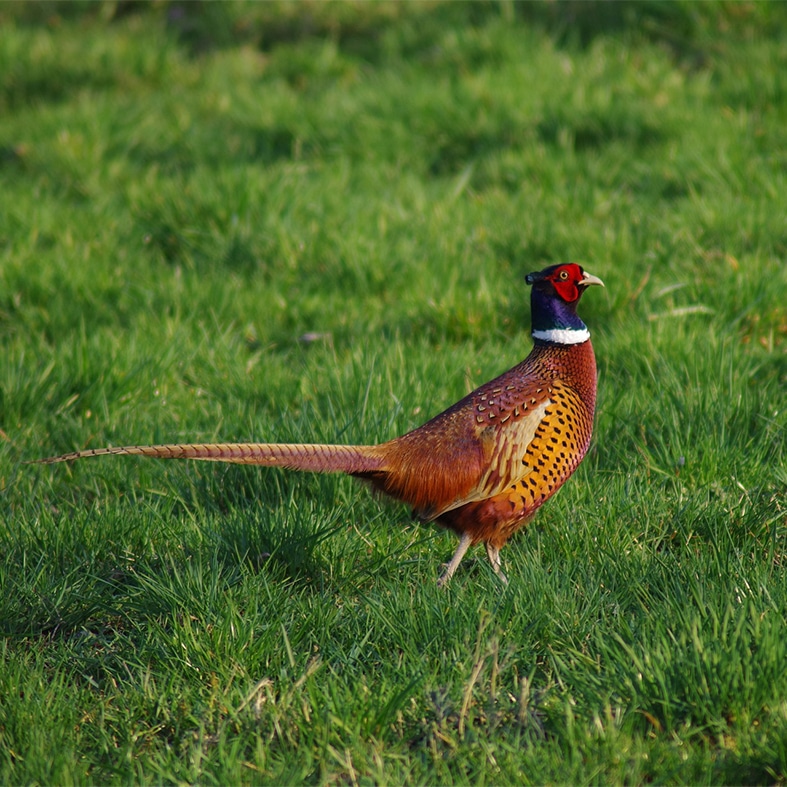

Home » Gamekeeping » Stock and poultry advice » Pheasant release pen scoring system checklist
Pheasant release pen scoring system checklist
| Essentials | Action | Yes/No | Score | ||
| 1. | Feeders and drinkers | Are at least 50% similar to those used in rear? | No=O Yes= 1 | ||
| Are all areas of the pen served by readily available drinkers and feeders (see note 1) and suitable quantity (see notes 2 &3) | No=O Nearly= 1 Yes= 2 | ||||
| Are feeders and drinkers well positioned (see note 2 &3) | No=O Some= 1 Yes= 2 | Total for section 1, out of 5 | |||
| 2. | Water | Water tested in this pen and suitable (see note 2) or proactive sanitiser use? | No=O Yes= 1 | ||
| Is water supply controlled? (see note 2) | No=O Yes= 1 | ||||
| Can water be easily medicated? | No=O Yes= 1 | Total for section 2, out of 3 | |||
| 3. | Food | Is food the same make as in rear? | No=O Yes= 2 | ||
| Are pellets the same size as in rear? | No=O Yes= 1 | Total for section 3, out of 3 | |||
| 4. | Roosting Area | Does at least 1/3 of pen contain trees suitable for roosting? | No=O Nearly= 1 Yes= 2 | ||
| Isroosting type ideal? (see note 4) | No=O Yes= 1 | Total for section 4, out of 3 | |||
| 5. | Area of cover | Does at least 1/3 of the pen have suitable groundcover that affords birds the ability to hideand feel confident and comfortable, and afford protection from the elements (see note 8) | No=O Yes= 3 | Total for section 5, out of 5 | |
| In this area is there any penetrating light? | No=O Some= 1 Yes= 2 | Total for section 5, out of 5 | |||
| 6. | Open area | Is there a significant open area with shorter vegetation? (see note 5) | No=O Some= 1 Yes= 2 | ||
| Is the open area close to easily available areas of cover? | No=O Yes= 1 | Total for section 6, out of 3 |
| Essentials | Action | Yes/No | Score | ||
| 7. | Pen conditions | Is there evidence of heavy contamination from previous years? (stale pen) | Obvious= 0 A little= 1 No =2 | Total for section 1, out of 5 | |
| Are there significant wet areas inthepen? | > 25% wet= 0 < 25% wet= 1 | ||||
| Stocking density (See note 6) | Above recommendations=0 Same or Below = 2 | ||||
| No more than 7-14 days in release pen | 14+ days= 0 Less than 14 days = 1 | ||||
| Easy access to pen for direct poult delivery (See note7) | No=0 Yes= 1 | ||||
| Is the release pen perimeter fence of adequate construction and maintained appropriately? | No=0 Yes= 1 | Total for section 7, out of 8 | |||
| 8. | Poultsat release | Are all the poults released from the same source? (see note 8) | No=0 Yes= 1 | ||
Are all the poults released at thesame time? (not topped up) | No=0 Yes= 2 | ||||
| Is there a carefully planned release time frame with consideration of weather? | No=0 Yes= 2 | ||||
| Wing clipping (See note 9) | Yes= 0 No=1 | Total for section 8, out of 6 | |||
| 9. | Predator and vermin control | Is there evidence of good predator control? | No=0 Yes= 1 | Total section 9, out of 1 | |
| 10. | Supervision | Are birds checked daily? | No=0 Once= 1 Twice= 2 > Twice= 3 | Total for section 10, out of 3 |
Guidance Notes for Vet/Auditor
- Feeders and drinkers must be available throughout the pen so birds cannot move to areas of the pen where they cannot easily find them. They should be positioned close to the margin of open areas and areas of cover so that the poults can feed and drink without being unduly frightened by aerial or other predators. Open areas and rides may offer easy access but should only be used if freedom from interference can be guaranteed..
- One 32cm diameter bell Drinker per 50 birds should be provided as a minimum. Equivalent to 2 cm per bird circular drinker space OR 3.8 cmsq drinker surface area per bird. If the pen is very large, then a higher ratio of feeders/drinkers will be necessary to cover all areas.
Water Targets
Very Poor | Coliform > 1000cfu/ml | TVC >1000 cfu/ml |
Poor | Coliform 10Ocfu/ml | TVC 100 cfu/ml |
Good | Coliform 0 cfu/ml | <100 cfu/ml |
Water tests should be performed annually and within 1 month of release. They should be performed at a minimum of 3 locations. Tests should be performed at all pens, or from the same pen but at different points (source/header/drinker).
Where possible, poults should only be able to drink from the water supplied to them via the water system. Where possible, external supplies such as streams, for example, should be excluded, at least for the first few weeks. Dirty puddles and standing water soon become contaminated with faeces and drinking from such should be prevented if at all possible. Feeders and drinkers should be moved to clean fresh areas periodically, but not moved so far as to cause the birds to “lose them”.
Header tanks or dosing systems should be used to provide the ability to medicate the birds if required.
- Equivalent to 125 birds per Mancia feeder MINIMUM ratio. Ideally aim for 1:50. If the pen is very large, then increased numbers of feeders may be required to cover all areas.
- Deciduous woodland is best. Coniferous woodland with no ground cover is poor. There should be a variation in heights of branches to enable birds to quickly learn to go up, and then higher branches to establish good roosting.
- Medium cover should be 30cm-150cm in height. Floor space should be covered with grass/ low lying plants. 0-30cm in height.
- Stocking of pens should follow the GWCT guidelines on release which states: 1000 birds per hectare of pen
700 birds per hectare of pen in ancient semi-natural woodland.
The higher the stocking density, the sooner birds should be allowed to disperse from the pen. At higher densities they should be in the release pen no more than 7-14 days. When refereeing to any possible effects on the environment that would be considered less than ideal, these should be recorded, and an improvement strategy introduced for future years. - Vehicle access must be possible to the pen.
- Birds from different sources should not be mixed within the same pen. (Different sources should be classed as different businesses supplying the birds, not different egg/chick suppliers providing the poult supplier.) Birds from the same supplier but from different batches should not be mixed in the same pen.
- The Defra Code of Practice for the Welfare of Gamebirds Reared for Sporting Purposes states: 5.1 The use of management devices or practices that do not allow birds to fully express their range of normal behaviours should not be considered as routine and keepers should work towards the ideal of management systems that do not require these devices. Such devices and practices include mutilations such as beak trimming, procedures to prevent or limit flight such as brailing (placing a band on a wing to prevent extension of the wing), trimming of non-sensitive flight feathers and specifically regarding wing clipping 5.8 Outer primary feathers may be clipped to restrict flight, but trimming growing feathers (“blood quills”) must be avoided if it constitutes interference with a sensitive tissue and would, therefore, be a mutilation.
- There should be evidence of a proactive approach to vermin and predator control such as electric fence wires around the pen and rat bait stations (with appropriate certification/licenses). A single straight line of feeders and drinkers should be avoided.
Total Score (out of 40)
30-40 Good
25-30 Adequate
<25 Poor/Not Suitable
Share

Small game preparation
All game preparation must be carried out with good food hygiene being the number one priority.

Shooting leases and shooting agreements
To secure your shooting opportunity, BASC strongly recommends that you take out a lease or shooting agreement with your landlord.

The use of red diesel for shoot transport
Many shoots transport the guns or beaters so it is important that all shoots are made aware of the restriction on using red diesel.








